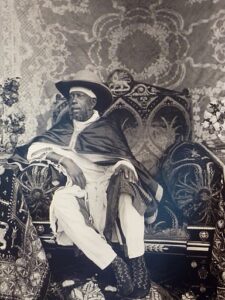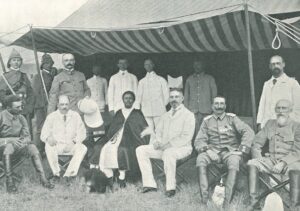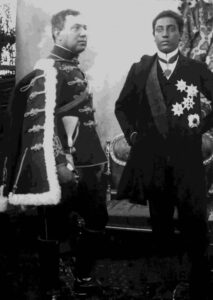The account of world history we know today was created with a European world viewpoint at its core. This eurocentric narrative of world events is colonial by its nature, white supremacist by its objective, aggressive by its methods, and expansionist by design. A major part of its agenda is to create the illusion of African inferiority. Global educational, religious, and media institutions were created to amplify and serve this eurocentric narrative. More than 50 years after the end of colonialism as a system, most people still view history through the limiting scope of eurocentricity.
Scholars and scholarly outputs, through the mechanisms of peer review and citations, perpetuate and pay homage to the same old racist thinkers, continually victimizing Black and Indigenous people of color. News media, motion pictures, and new Artificial Intelligence technologies continue to base their content on this biased mass of data, which has been in circulation since the invention of the printing press.
Was Europe really at the center of all major world events? What would you say if I told you that the two World Wars didn’t start in Europe?
I know that an article will not be able to change a 500-year-old cemented narrative about the superiority of one race against the rest of the world. My expectation here is not to convert your way of thinking overnight, but rather to ask you to question the sources of historical knowledge we have acquired collectively, to look carefully at current affairs, and to consume media cautiously.
We all were taught that World War I, which claimed 16 million people in four years, began in 1914 after the assassination of Archduke Franz Ferdinand in Sarajevo. The war was fought between the Central Powers (Germany, Austria-Hungary, the Ottoman Empire, and Bulgaria) and the Allied Powers (France, Great Britain, the Russia Empire, and Japan), which grew out of the Triple Entente of France, Great Britain, and the Russian Empire.
The question is when and where were these political alignments were first made? And why?
The answer can’t be found in any of the 21 combatant countries involved in the war in Europe or the place where the Duke was killed. The beginning lies in a far away country on a different continent, almost a decade earlier.

Emperor Menelik II
It all began 125 years ago this week, when Emperor Menelik II of Ethiopia defeated the Italian colonial power at Adwa on March 1, 1896, and initiated a major railway line project.
On the March 9, 1894, the Emperor signed a decree granting Alfred Ilg, the Emperor’s advisor and a Swiss engineer, and Léon Chefneux, a French engineer, to work on a railway between the port of Djibouti and the capital of Ethiopia. The railway was intended to open up the Ethiopian Empire, which is landlocked, to further trade on the Red Sea.[1] This, however, created a conflict over the contract that lasted for almost a decade between the French, who controlled the small port protectorate of Djibouti, and the British, who controlled the majority of North-Eastern Africa (including Egypt, Sudan, Kenya, Uganda, and Somaliland). The conflict was exacerbated by the Bonheur-Chefneux Convention of 1902, when Ilg and Chefneux sold the concession to the French government, giving them much more territorial power than initially stated — a significant advantage over the British Empire.[2] This stalemate ended on April 8, 1904, with the Anglo-French Entente Cordiale. The Entente, which settled colonial tensions both inside and outside of Africa, brought the British government into the contract, giving them more sway over the future of the railroad than was originally given by Menelik II.[3] Since the Entente was also a promise to support each other’s East African interests against German influence, the French government privately intended to use the agreement to attempt a French monopoly on the Ethiopian markets. British opposition to this came not from a place of support for Ethiopian sovereignty, but as an objection to any European monopoly that wasn’t their own.

Ras Mekonnen and the German Mission
At the end of the same year, Germany sent a mission to the Emperor’s court and, on March 7, 1905, signed a commercial treaty with Ethiopia. The treaty, paired with Germany’s growing military strength and renewed European tensions in Ethiopia, put the positions of France and Britain in Ethiopia in danger. This led France, Italy, and Britain to sign the Tripartite Treaty of December 13, 1906, which concerned Ethiopian sovereignty and the railroad construction. Though the treaty on its surface settled the commercial differences between the three nations, it was essentially a contingency plan for the death of Menelik II. Without any consent from the king, it allotted each nation a sphere of influence in Ethiopia, setting up a confrontational dynamic between the Ethiopian government and the Europeans.[4] The Tripartite Treaty paved the way for the participants’ cooperation against Germany — a decade preceding World War I.
In 1909, Emperor Menelik II declared Iyasu, his grandson, as his successor. In the years that followed, and during the Emperor’s sickness, Iyasu served as regent under Empress Tayitu. During this time, the Germans got much closer to the court and appointed the physician of the emperor, the tutor of Lij Iyasu, and the advisor to the Justice Minister. In July 1914, the same month that World War I began, Emperor Menelik and Empress Tayitu formalized this close relationship by signing a collaborative agreement with Germany. When the emperor died, Iyasu officially inherited strong relationships with the Germans and the emperor’s close advisor, Hassib Yidlibi, a Turk of Syrian origin, whom he appointed as his adviser and government official in Dire Dawa, a town adjacent to Djibouti.
A modernizing ruler, Lij Iyasu wished to create a nation as multiethnic and multireligious as himself and to decolonize Eritrea and Somalia from Italy, Somaliland from Britain, and Djibouti from France. Unfortunately, he got caught up between his allies (the Germans and the Ottomans) and “the colonizers [who] are deliberately in favor of [Ethiopia’s] weakness through the religious and ethnic conflicts.”[5] Each of these nations (Germany, Britain, France, Italy, and the Ottoman Empire) sought to gain Iyasu’s alliance in order to secure the Red Sea as a military and economic asset. For the Central Powers, establishing a stronghold in East Africa was necessary to take control of the Suez Canal and sever Britain from its African colonies.[6] In addition, Germany, like the other European powers, was interested in gaining access to African resources through colonization. Beginning in 1904, Germany sent a series of exploratory expeditions led by scholar Leo Frobenius, allegedly to further Germany’s academic knowledge of the continent of Africa. However, the 1915 expedition to the Horn of Africa was a cover for an espionage mission meant to coax Iyasu into the Central Powrs.[7] Similarly, the purpose of the Ottoman Empire’s envoy was to support Lij Iyasu’s plan to unify East Africa and use it against the British and the French. Both the Germans and the Ottomans attempted, independently and through Iyasu, to incite various tribes living under French and British rule into rebellion in the hopes that, once war broke out, it would cause further turmoil within the empires.
 While the Germans and the Ottomans supported Lij Iyassu, the uncrowned emperor from 1913 to 1916, the opposing faction (Great Britain, France, and Italy) conspired against him. The British and French governments both felt that Iyasu was jeopardizing their East African holdings; from the beginning of his reign, he had launched a campaign to strengthen and support tribes on the borders of the nation, leading to conflicts with the colonial forces, which included train derailments and attacks.[8] In retaliation, the British and French attempted to cut off Ethiopia from any other of its European allies. In 1915, they intercepted two separate German attempts to contact Ethiopia — one of which was the Frobenius expedition, which was rerouted to Italy. Locally, they intensified their attack on Iyassu’s reputation and supported his rival Teferi Mekonnen, the Francophone future emperor. Accounts from Armenian ambassadors at the time allege a British bribery attempt, in addition to a negative propaganda campaign spread throughout the Horn of Africa.[9] On September 27, 1916, Iyasu was deposed, allowing Great Britain and France to hold on to their fledgling colonies in the Horn of Africa. In 1917, Menilek II’s daughter, Zauditu, became empress, and Ras Tafari was named regent and heir apparent to the throne.
While the Germans and the Ottomans supported Lij Iyassu, the uncrowned emperor from 1913 to 1916, the opposing faction (Great Britain, France, and Italy) conspired against him. The British and French governments both felt that Iyasu was jeopardizing their East African holdings; from the beginning of his reign, he had launched a campaign to strengthen and support tribes on the borders of the nation, leading to conflicts with the colonial forces, which included train derailments and attacks.[8] In retaliation, the British and French attempted to cut off Ethiopia from any other of its European allies. In 1915, they intercepted two separate German attempts to contact Ethiopia — one of which was the Frobenius expedition, which was rerouted to Italy. Locally, they intensified their attack on Iyassu’s reputation and supported his rival Teferi Mekonnen, the Francophone future emperor. Accounts from Armenian ambassadors at the time allege a British bribery attempt, in addition to a negative propaganda campaign spread throughout the Horn of Africa.[9] On September 27, 1916, Iyasu was deposed, allowing Great Britain and France to hold on to their fledgling colonies in the Horn of Africa. In 1917, Menilek II’s daughter, Zauditu, became empress, and Ras Tafari was named regent and heir apparent to the throne.
At the same time, the feud that started in Ethiopia, 3,000 miles away from Europe, grew worse. With the June 28, 1914 assassination of Archduke Franz Ferdinand by a Serbian nationalist, Austria-Hungary declared war on Serbia. A few weeks later, Russia got involved to protect Serbia, its ally. Three days later, Germany declared war on Russia, supporting Austria-Hungary. Then, Great Britain declared war on Germany to protect Belgium and France. So went the dominos, starting one of the most devastating wars in world history.
Even though we don’t usually read it in our history books and see it in the many films made on the subject, not only were the important alliances of World War I initiated in Africa, but 250,000 African lives were also sacrificed in the conflict, out of more than two million who were involved as soldiers and labourers for the Central Powers. On the other side, about half a million African soldiers were also deployed by the Allied Powers.[10]
After four years, during which nine million soldiers perished and 21 million more were wounded, the “war to end all wars” ended on November 11, 1918, with Germany signing an armistice and surrendering. The next year, on June 28, Germany and the Allied Nations signed the Treaty of Versailles, formally ending the war. The following year, on January 10, leaders of the United States, Great Britain, and France met in Versailles and established the League of Nations. Germany, Austria, and Hungary were not invited.
While Europe was engulfed in its war, in Ethiopia, the Shewan nobility defeated Lij Iyasu and successfully transitioned into power, with Empress Zewditu as their queen and Ras Teferi Mekonnen as the regent at the helm. For Great Britain, France, and Italy, this development was a great success, as they continued to maintain their colonies in the Horn of Africa, but it was a devastating double defeat to the Germans and the Turks, as they lost on both fronts.
For Ethiopia, too, this success continues to have a negative generational impact, as the winning Shewan nobility (later dubbed Neftegna) would be blamed as the new arch enemy of their own fellow countrymen — Tigrayans, Oromos, Wolloyes, Gojjams, Somalis, and others — who were taught to hate them for all the shortcomings of the society. Books and education were used as a vehicle of creation, conversion, and propagation of discord and disunity within Ethiopia.
The new global players in the region are no longer France, Italy, Great Britain, and Germany. Today, China, the United Kingdom, the European Union, the US, Russia, India, Brazil, Turkey, Iran, South Korea, and the Gulf nations are all working hard to expand their spheres of influence. If our reading of current affairs and history is correct, what is starting in the Horn of Africa is yet another World War “Scramble for Africa.”
Until the end of 2020, the love-hate relationships between Donald Trump, Xi Jinping, Vladimir Putin, and Recep Tayyip Erdoğan drastically shifted global alliances, potentially propelling the region and the world towards another devastating set of conflicts on the order of what took place in the 1910s and 1940s. Trump’s endless interference in the Grand Ethiopian Renaissance Dam’s negotiation between Egypt, Sudan, and Ethiopia got us closer to the precipe, but his loss of power seemed to have given us another four years of peace. Unfortunately, Joe Biden’s administration and his Secretary of State Antony Blinken seem to lead us down the same path. Making things worse, earlier this month, the US and Russia moved their warships to Sudan shores, Turkey sided with Ethiopia against her former ally Egypt, and China signed a pact aimed at “establishing security safeguarding mechanisms” to her Belt and Road Initiative in Ethiopia, including the Addis Ababa-Djibouti Railway.[11] A century later, with new actors at play, the region is facilitating confrontations similar to those that culminated in World War I.
Might Ethiopia be where the third World War begins? Only time will tell. In the past, the dominant colonial narrative has been a blind spot in our assessment of global politics and its unfolding drama. If we don’t broaden our understanding the world and of our place in it, we will end up victims of our own collective ignorance. Liberating our minds and rereading history from a new perspective is not a choice but an obligation.
¤
¤
Photograph: Lij Iyasu, 1914.
¤
[1] Thomas Lennox Gilmour, Abyssinia: The Ethiopian Railway and The Powers (London: A. Rivers, 1906), 7-9.
[2] Shiferaw Bekele, “Some Notes on the Genesis and Interpretation of the Tripartite Treaty,” Journal of Ethiopian Studies 18 (November 1985), 64-65: www.jstor.org/stable/41965928
[3] Edward C. Keefer, “Great Britain, France, and the Ethiopian Tripartite Treaty of 1906,” Albion: A Quarterly Journal Concerned with British Studies 13, no. 4 (Winter 1981), 370: www.jstor.org/stable/4048642
[4] Shiferaw Bekele, “Some Notes on the Genesis and Interpretation of the Tripartite Treaty,” Journal of Ethiopian Studies 18 (November 1985), 74: www.jstor.org/stable/41965928
[5] The First World War as a Turning Point / Wendezeit Weltkrieg: The impact of the years 1914 -1918 on Church and Mission (with special focus on the Hermannsburg Mission). Editor Frieder Ludwig; Publisher LIT Verlag
[6] “How Ethiopian Prince Scuppered Germany’s WW1 Plans.” BBC, September 25, 2016. https://www.bbc.com/news/world-37428682.
[7] Patrick Gilkes and Martin Plaut, “Great War Intrigues in the Horn of Africa”, in The First World War from Tripoli to Addis Ababa (1911-1924), edited by Shiferaw Bekele et al. (Addis Ababa: Centre français des études éthiopiennes, 2018) 1-8.
[8] Plaut, “Great War Intrigues,” 14.
[9] Richard Pankhurst, “The Reign of Lïj Iyasu as Avedis Terzian Saw It,” in The Life and Times of Lïj Iyasu: New Insights, edited by Éloi Ficquet and Wolbert G. C. Smidt (LIT Verlag, 2014), 91.
[10] Shiferaw Bekele et al., eds., The First World War from Tripoli to Addis Ababa (1911-1924) (Addis Ababa: Centre français des études éthiopiennes, 2018).
[11] “China, Ethiopia ink accord on establishing security safeguarding mechanism for major projects under BRI.” Xinhua (March 07, 2021): http://www.xinhuanet.com/english/africa/2021-03/06/c_139790042.htm
Delegation a group of representatives or delegates More (Definitions, Synonyms, Translation)






